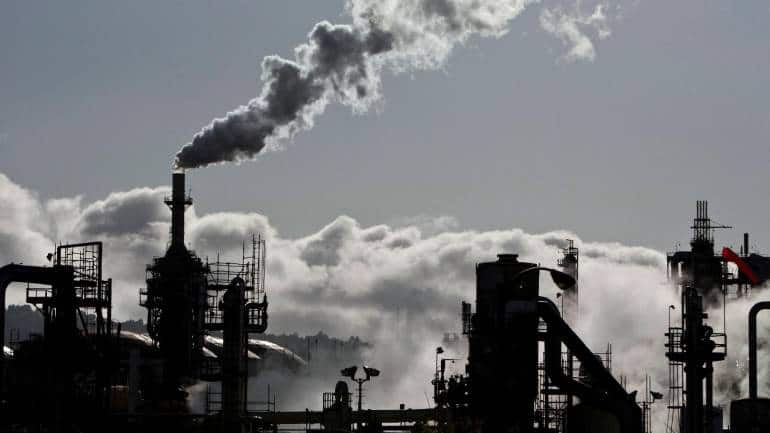Tokyo Olympics 2020 |Cycling: Golden Ganna powers Italy to victory in team pursuit thriller
 ]
]
Filippo Ganna inpired Italy to a long-awaited gold medal in the men’s team pursuit as they produced an electrifying finish to stun favourites Denmark in a see-sawing final at the Izu Velodrome on Wednesday.
The Azzurri trailed in the closing stages of the 16-lap duel but lead engine Ganna turned up the power and they blasted across the line in a world record 3:42.032, with the Danes an agonising 0.166 slower.
Italy’s quartet of Ganna, Simone Consonni, Francesco Lamon and Jonathan Milan, who had also set a world record on Tuesday, celebrated wildly, thumping their fists into their chests, after delivering their first gold in team pursuit since 1960.
The blue-clad Italian train led for the first half of the 16 laps around the 250-metre oval, but Denmark piled on the pressure to reel them in.
The Danes then turned the screws to open up what looked like a decisive lead, and with less than four laps remaining their foursome of Lasse Norman Hansen, Niklas Larsen, Frederick Madsen and Rasmus Pedersen had a buffer of almost a second.
But Italy were not done. Ganna lit the fuse, and the four began burning down the deficit. With a lap remaining Denmark still had gold in their sights but it slipped away in the final 100 metres as Italy claimed a record-extending eighth title - and their first in over 60 years.
“We knew we were fighting against a very good team. We knew we had to attack them in the last km and that’s what made the difference,” Ganna told reporters. “The plan went well and now we have the gold medal around our necks.”
It was quite a comeback by Ganna who missed out on a medal by two seconds in the 44km road time trial.
Team mate Lamon added: “This is a gift for all the group because it’s been five years we started working for this. We have a beautiful, beautiful team. Like a family.”
For the Danes it was a crushing blow having arrived in Tokyo as favourites to win the title for the first time since 1968.
“We’re incredibly disappointed right now. We’ve been training towards and hoping for gold for such a long time, so right now we are super disappointed,” Hansen said.
“We lost to a team that went a few hundredths faster than us. That is devastating, but we can be proud of silver.”
Australia won the ride-off for bronze after New Zealand suffered a crash. Britain, who had bossed the event since 2008 but were thrashed by the Danes in controversial circumstances on Tuesday, had to settle for seventh.
Denmark ripped up the team pursuit blueprint when they smashed the world record three times to win gold at the 2020 world championships in Berlin.
They arrived as the team to beat but became mired in controversy on Tuesday after protests from other teams, notably Britain, that they had used illegal taping on their shins to gain an advantage in Monday’s qualifying rounds.
They outclassed the defending champions Britain on Tuesday but that heat ended controversially when Frederick Madsen ploughed into the back of Charlie Tanfield, leading to more objections from the British.
Perhaps it took a toll on the Danes, but the Italians did not care as their anthem sounded around the arena.
The men’s sprint got under way on Wednesday flying Dutchmen Jeffrey Hoogland and Harrie Lavreysen living up to their favourites’ tag in the opening rounds.
Having combined to win gold in the team sprint the day before, they could not be separated as they set an identical time of 9.215 in the 200m flying start.
Both then eased through two more rounds to take their place among the last 12 who will go again on Thursday.
Reigning champion Jason Kenny, who settled for silver in the team sprint, was only eighth-fastest in the 200m flying start but made it safely through the day as did team mate Jack Carlin.
Humanity Can Still Take a Stand on Climate. It Must.
 ]
]
Representative Image
In June 1988, a NASA scientist, Dr. James Hansen, appeared on a very hot day in Washington and told a group of powerful senators that a grim future lay ahead. Carbon emissions, he said, had raised average global temperatures to the highest levels in recorded human history, bringing heat waves, droughts and other disruptions to people’s lives. “The greenhouse effect has been detected,” he said, “and it is changing our climate now.”
That same year, a collection of scientists assembled by the United Nations — known as the Intergovernmental Panel on Climate Change — delivered much the same message, warning pointedly of rising seas and threats to biodiversity. Four years later, world leaders meeting in Rio de Janeiro signed a landmark agreement to stabilize “greenhouse gas concentrations in the atmosphere at a level that would prevent dangerous anthropogenic interference with the climate system.”
We knew, three decades ago, about global warming and its consequences. We suspected, even then, that the potentially catastrophic future forecast in the IPCC’s latest report, released Monday — a report U.N. Secretary-General António Guterres called a “code red for humanity” — could well come to pass.
What have we done with that knowledge? Very little, for lots of reasons. Timid leaders, feckless legislatures. Interminable arguments between rich and poor nations over who bears responsibility. Well-financed disinformation campaigns from big polluters like Exxon Mobil. On a purely human level, there’s the reluctance of people living worry-free in the here and now to make the investments and sacrifices necessary to protect future generations.
All in all, the past 30 years have been a colossal series of missed opportunities. Good ideas squandered. Time lost. The performance of the United States, historically the world’s biggest emitter of greenhouse gases (China is now the biggest annual emitter) and therefore presumed leader of any effort to confront the problem, has been particularly disheartening.
President George H.W. Bush, having boldly promised to counter the “greenhouse effect” with what he called “the White House effect,” had to be dragged kicking and screaming to the Rio conference, where he made sure that the treaty signed there had no real teeth. Similarly blinded by fossil fuel interests and worried that the United States was being asked to carry a disproportionate share of the burden, Congress in 1997 refused to even consider, much less ratify, the agreement worked out by Vice President Al Gore in Kyoto, Japan, to reduce emissions from industrialized nations.
President George W. Bush — who, like his father, talked a good game in his campaign — was no better. Hypnotized by the fossil fuel enthusiasts around him, notably Karl Rove and Vice President Dick Cheney, he repudiated Kyoto altogether, greatly embarrassing his Environmental Protection Agency administrator, Christie Whitman, who eventually quit. Even President Barack Obama, who understood the issue and appreciated its gravity but was fatally detached when it came to legislative infighting, fell short. He failed to persuade a Congress controlled by his own party to cap emissions of carbon dioxide.
Obama partly compensated for this with an admirable suite of regulatory initiatives aimed at reducing emissions from vehicles, oil and gas wells, and power plants, which gave John Kerry, then the secretary of state, the credibility he needed to help forge a new global treaty in Paris in 2015. But these initiatives were always vulnerable to repeal and were unsurprisingly and expeditiously repudiated by President Donald Trump, who seemed to have no idea what climate change was all about and had no interest in learning.
Such is the weight of history that President Joe Biden bears as he faces an opportunity to assert American leadership in advance of a global summit on climate change in Glasgow, Scotland, in November. There, it is hoped that the 190 or so countries in attendance will greatly improve on the commitments they made in Paris to reduce emissions. The Washington Post has called this meeting a “moment of truth” for climate change. To anyone who has read the IPCC report, that is not journalistic hyperbole.
The report’s main points are these: First, nations have waited so long to curb emissions that a hotter future is essentially locked in, as are more droughts, more forest fires, more crippling heat waves, more sea level rise, more floods. The greenhouse gases that have already been pumped into the atmosphere are going to stay there a long time, inflicting misery for years to come.
This summer has already produced huge floods in Central Europe, Nigeria, Uganda and India; blazes in Greece and Siberia; wildfires erasing entire towns in California and Canada; murderous heat waves in the Pacific Northwest; and the drying up of Colorado River reservoirs. “What more can numbers show us that we cannot already see?” asked one U.N. climate official. Fair question. But what the numbers show is that these meteorological calamities will become routine unless the world takes dramatic steps to get a grip on emissions.
In their analysis of the new report, New York Times reporters Henry Fountain and Brad Plumer offer this illustration. Humans have already heated the planet by roughly 1.1 degrees Celsius, or 2 degrees Fahrenheit, since the 19th century. If global warming rises to around 1.5 degrees Celsius in the next 20 years, heat waves that would have occurred once every 50 years can be expected to show up once every 10 years. At 4 degrees of warming, they’ll show up every year.
Point two: Humanity can still take a stand. It must. If countries make a coordinated effort to stop adding carbon dioxide to the atmosphere by, say, midcentury and undertake, through reforestation and other means, to remove carbon from the air, global warming might level off at around 1.5 degrees. This in turn means mustering the will to stave off a darker future than the one the world has already locked itself into. It also means, in policy terms, a rapid shift away from fossil fuels; big investments in wind, solar and nuclear power; a rebuilt electric grid; and more efficient homes and buildings — in short, a wholly different energy delivery system.
Earlier this month, Biden announced a strategy to shift Americans from gasoline-powered cars to electric vehicles, thus resurrecting an Obama initiative Trump had canceled. This is an important step. But Biden is not going to get the energy transformation he wants via regulation any more than Obama could. For this, he will need Congress.
Can Congress deliver? No small question. The Senate, split evenly between the parties, took forever to approve an infrastructure bill, which has only modest climate-related measures in it and should not have been all that controversial. Ahead lies something a lot more difficult: winning approval of a giant $3.5 trillion budget reconciliation bill that can be approved with only 51 votes (all the Democrats and the vice president), thus avoiding a Republican filibuster and opening a legislative pathway for a range of big-ticket social programs and Biden’s climate policies.
Of these, two are of paramount importance and are essential to honoring Biden’s campaign promise to cut America’s emissions in half by 2030, eliminate fossil fuel emissions from power plants by 2035 and zero out all greenhouse gases by midcentury — pretty much what the IPCC wants. One is billions in incentives for electric vehicles and for clean energy sources like wind, solar and nuclear power. The other is a clean electricity standard that, as currently envisioned, would reward power producers that reduce emissions and penalize those that don’t. There are likely to be add-ons from individual senators, like Chris Van Hollen’s proposal, unveiled this month, to tax Exxon, Chevron and a handful of other major oil and gas companies to get them to pay for floods, fires and other disasters linked to the fossil fuels they have produced over the years.
How great would it be if the Senate and then the House approved such a package before the climate summit in Glasgow? One person who would shout to the rafters is Kerry, once again the White House’s point man on international negotiations. He’ll be the face of America’s resolve in Scotland, and he’ll need tangible evidence to prove that Washington cares. Congress can give it to him.
OPEC+ reconvenes after wrangling over production rise
 ]
]
Source: Reuters
The members of the OPEC+ alliance of oil producing countries reconvened on Friday, a day after failing to reach agreement on production quotas from August onwards.
Thursday was a busy day of video-conferencing for the alliance’s ministers, starting with a meeting between the 13 members of OPEC proper led by Saudi Arabia, followed by a technical meeting (JMMC) and full discussion between the 23 members of OPEC+.
The wider grouping includes Russia, the world’s second-largest oil producer.
The 23 states in the alliance restarted a technical meeting (JMMC) at around 1500 GMT – two hours behind schedule – with the crucial OPEC+ ministerial meeting to discuss future policy expected to follow.
A Russian government spokesman said “work was continuing” on an agreement, but refrained from commenting when asked if the current impasse could produce a crisis like that seen in March 2020.
Back then, a falling out between Moscow and Riyadh sent US crude prices below zero for the first time in history.
The hitch in Thursday’s discussions came “due to the UAE raising a last minute objection to the Russian-Saudi Arabia deal reached earlier in the day”, according to analysts from Deutsche Bank.
“The UAE, which has raised its production capacity since 2018 when the individual baselines were set, insisted on having its baseline lifted by 0.6 million barrels per day (bpd) to 3.8 million bpd, thereby allowing them a unilateral production increase within the current quota framework,” according to Ole Hansen from Saxobank.
“Negotiations today will be difficult as OPEC+ knows that if the UAE is allowed to produce from a different base, other members may protest,” said Louise Dickson from Rystad.
- Complex market -
The Bloomberg agency reported on Thursday that an agreement had been floated which would involve raising production by 400,000 barrels per day (bpd) each month from August onwards, reaching an extra two million bpd by the end of 2021.
This would fit the broad strategy followed by OPEC+ since May: gradually increasing output which it had drastically cut in reaction to the collapse in demand at the beginning of the pandemic.
Since the beginning of the economic crisis the group has held almost monthly meetings to coordinate their response.
Their strategy has succeeded in steering prices back upwards – they are now at levels not seen since October 2018.
The alliance has to navigate a complex market, characterised by an uptick in demand which may yet turn out to be fragile, as well as the possible complication of a return of more Iranian exports in the medium term.
In addition, current high prices are prompting grumbles from large crude consumers such as India.
Also expected to be on the agenda on Friday will be whether the OPEC+ can extend its current production deal “through to the end of 2022”, noted Neil Wilson from Markets.com.